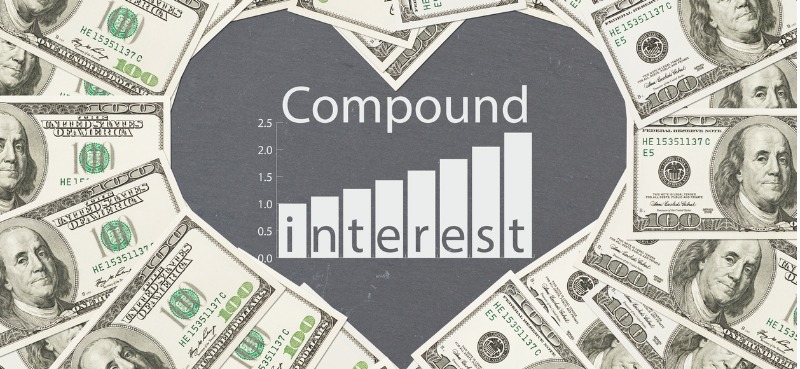“A penny saved is a penny earned” is often attributed to Benjamin Franklin.
But in fact he said something slightly different: ”A penny saved is two pence clear,” meaning for every penny we don’t spend, we’re twice as rich.
I tend to think of investment income—such as dividends or capital gains—in a similar way: If you don’t immediately need income, you have two options: You can save the dividend payout… or, better yet, invest it. The latter option means it can grow—and the growing income can be used later when you need it.
Reinvesting dividends is one great—and very simple—way to grow your wealth.
Today, I’ll go over how this method works… and share a few details that can make a big difference in the final outcome.
Let’s start with the most important reason to consider dividend reinvestment: compounding.
Compounding is one of the most important concepts in finance… and it’s the key to wealth accumulation, especially longer-term.
So what is it?
It’s the process of crediting the interest (or dividends) from an asset back to the same asset.
If you reinvest dividends each time you get them, you put more money into the stock… and create a slightly larger position. The next time the dividend is due, you’ll get a slightly higher payout. Repeat for as long as you don’t need income—or for as long as you are willing to hold the stock—and your position will grow faster and faster, without much effort on your part.
Eventually, the value of your portfolio will accelerate at an astonishing rate…
In an earlier article, I illustrated how much you can earn given various investment timeframes. As you’ll see, time is the most valuable component of compounding. The sooner you start, the more your money can do for you.
For the mathematically inclined among you, here’s the formula used in compounding, together with two examples.
(For simplicity, this example uses a 20% interest rate—but you can use any number in these calculations.)
If you’re earning 20% interest, it can turn into 21% if you compound it semiannually (equation 1) or into nearly 22% if you compound it monthly.

If you’re not mathematically inclined, think about it this way: Many credit cards charge a 20% interest rate or more…
Some cards compound interest monthly, and some do it daily… multiplying the interest rate by the amount owed at the end of each day, then adding the interest amount to the end-of-day balance. The debt grows faster this way—again, thanks to the power of more frequent compounding.
Credit cards are a good example of how compounding can work against you.
But we’re here to talk about using the power of compounding to earn money.
And by reinvesting dividends back into the securities that pay them, you’ll accumulate money faster.
A single reinvested dividend of, say, 2% makes your position 2% bigger… and also boosts its income generation potential by 2%.
The longer you do it, the faster your position will grow.
The beauty of this strategy is in its simplicity…
Every time a dividend or interest payment is issued, you’re building a bigger principal amount to earn income on the next time period. And so on and so on…
Let’s say you own 100 shares of Acme you bought for $100 per share.
Acme yields 4% at current prices. This means the stock pays $1 per share in quarterly dividends… or $100 in income on your 100 shares every three months.
But you don’t need this income… and you opt to reinvest these dividends at Acme’s current price of $95 per share. This means you can buy an additional 1.053 shares and add them to your position.
This translates to a larger position of 101.053 shares… and a higher next-quarter income of $101.053 in dividends.
If, when the next quarter-end comes around, the stock has declined to $90 per share, reinvesting this new dividend at $90 per share will buy you an additional 1.123 shares… and brings the number of shares you own to 102.176.
Your third quarterly dividend will be $102.176… and you can reinvest it again. If the stock price rises back to $100 per share, you can buy 1.0218 shares… and increase your holding to 103.198 shares.
In less than a year, you’ve increased your share count by almost 3.2%, and ensured a growing payout.
By executing this strategy, you’ve also benefited from Acme’s temporarily lower share price… and bought more shares for the same dollar amount of dividends.
There’s more to this strategy, of course.
Just like the credit card example I mentioned earlier, the frequency of interest compounding matters… So the more frequently you reinvest dividends, the faster your income (and final returns) will grow.
Most U.S. stocks pay dividends quarterly. But some—such as Realty Income (O), a real estate investment trust (REIT), or Main Street Capital (MAIN), a specialty investment company—as well as some exchange-traded (ETF) or closed-end (CEF) funds—pay dividends monthly. For them, the effect of compounding is even more pronounced.
Of course, you shouldn’t buy anything just for dividends or for their reinvestments.
But if you like the asset, and you plan to reinvest dividends… and your stock/fund of choice pays its distribution monthly—even better.
It’s easy to arrange for dividend reinvestments; most brokers can set it up for you.
A great income stock can pay you for years and help your wealth grow… Just watch out for one pitfall: If you continuously reinvest dividends in just a few of your portfolio holdings, there’s a chance they’ll eventually account for a much larger share of your portfolio than you intended.
But this overconcentration risk is a small price to pay for using the power of compounding for maximum benefit.
P.S. One of my specialties is identifying safe dividend payers… but with the kind of upside you’d expect from growth stocks.
For access to a portfolio full of these assets, join us at Unlimited Income. Our strategy is one of the surest paths to real wealth, with very little effort…




















